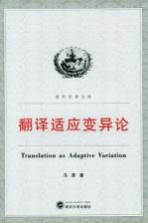

青年学者文库 翻译适应变异论PDF电子书下载
- 电子书积分:10 积分如何计算积分?
- 作 者:马萧著
- 出 版 社:武汉:武汉大学出版社
- 出版年份:2012
- ISBN:9787307099593
- 页数:228 页
Chapter 1 Introduction 1
1.1 Preview 1
1.2 Object of the research 3
1.3 Rationale of the research 7
1.4 Problems with the existing translation studies 13
1.5 Objectives of the research 14
1.6 Key research questions and hypotheses 15
1.7 Research methodology 16
1.8 Significance of the research 17
1.9 Structure of the research 18
Chapter 2 Review of the Relevant Literature 20
2.1 Introduction 20
2.2 A meta-theoretical thinking of translation studies 21
2.2.1 Different focuses of investigation 21
2.2.2 Problems of translation studies 31
2.2.3 Problems with research methodology 47
2.2.4 Some taken-for-granted facts in translation studies 52
2.3 Studies related to translational variations 55
2.3.1 Translation shift 55
2.3.2 The variational approach 61
2.3.3 Huang's study on special variations in translation 63
2.3.4 Hu's adaptation and selection approach 63
2.4 Summary 65
Chapter 3 A Description of Adaptation-Theoretic Framework 66
3.1 Introduction 66
3.2 Introduction to adaptation theory 66
3.2.1 Pragmatics as a general functional perspective 66
3.2.2 Theory of linguistic adaptation 69
3.2.3 Four angles of investigation 72
3.2.4 Three properties of language 76
3.3 An adaptation-theoretic approach to translation as adaptive variation 78
3.3.1 Contextual correlates in translational context 80
3.3.2 Translation as translator-centered 84
3.3.3 Language properties as prerequisites for translation operation 85
3.3.4 Translating as dynamic processes of making choices 87
3.3.5 Salience as cognitive filter 88
3.3.6 Translation as realization of adaptation 89
3.3.7 Translational variation as the result of adaptation 91
3.4 Summary 92
Chapter 4 Salience as a Cognitive Filter 93
4.1 Introduction 93
4.2 The Cognitive nature of salience 93
4.2.1 The notion of salience 93
4.2.2 Degree of salience 94
4.2.3 Dynamics of salience 95
4.3 Salience of the ST features 98
4.4 Salience of the TT norms 99
4.5 Salience of sociocultural context 101
4.6 Salience to the translator 102
4.7 Salience as a cognitive filter 104
4.8 Summary 105
Chapter 5 Adaptability of Translation 106
5.1 Introduction 106
5.2 Linguistic adaptability 106
5.3 Translational adaptability 108
5.3.1 Terminological problem and ambiguity 109
5.3.2 Redefining adaptation or adaptability 111
5.4 Bidirectionality of adaption 113
5.5 Obligatory adaptation 116
5.5.1 Adaptation to the rules of phonological patterns 117
5.5.2 Adaptation to the rules of syntactical structure 119
5.5.3 Adaptation to the rules of textual organization 121
5.6 Optional adaptation 131
5.6.1 Interpersonal adaptability 132
5.6.2 Intertextual adaptability 144
5.6.3 Sociocultural adaptability 153
5.7 Summary 171
Chapter 6 Variability of Translation 173
6.1 Introduction 173
6.2 Linguistic variability 173
6.3 Translational variability 176
6.4 Possibilities of translational variation 179
6.4.1 Variability of linguistic forms 180
6.4.2 Variability of semantic content 183
6.4.3 Variability of pragmatic function 185
6.4.4 Variability of text type and text function 187
6.5 Variation as dynamic processes of choice making 190
6.5.1 Dynamic choice making of ST interpretation 190
6.5.2 Dynamic choice making of TT production 192
6.6 Variation as Translation Strategy 194
6.7 Variation as Translational Creativity 195
6.8 Translational products as a continuum of variations 197
6.9 Summary 199
Chapter 7 Translation as Adaptive Variation:A Unified Account 201
7.1 Introduction 201
7.2 Translation as adaptive variation 202
7.3 Principles of translation 203
7.3.1 Adaptation principle 204
7.3.2 Conditioning principle 205
7.3.3 Variational principle 206
7.4 A Unified account of translation 207
7.4.1 ST as source of information for translation 207
7.4.2 TT as communicative text in target culture 208
7.4.3 Paradoxes and disputes revisited 209
7.4.4 Translatability reconsidered 211
7.5 Summary 213
Chapter 8 Conclusion 215
Bibliography 219
- 《中国当代乡土小说文库 本乡本土》(中国)刘玉堂 2019
- 《培智学校义务教育实验教科书教师教学用书 生活适应 二年级 上》人民教育出版社,课程教材研究所,特殊教育课程教材研究中心编著 2019
- 《英汉翻译理论的多维阐释及应用剖析》常瑞娟著 2019
- 《当代翻译美学的理论诠释与应用解读》宁建庚著 2019
- 《社会文化系统中的翻译》姜秋霞,杨正军 2019
- 《2020考研英语大趋势 历年真题完形+翻译+新题型精讲精练》商志 2019
- 《大鱼文库 在路上》杰克·凯鲁亚克 2020
- 《天水师范学院60周年校庆文库 新工科视域下的工程基础与应用研究》《天水师范学院60周年校庆文库》编委会编 2019
- 《潜文本的阐释与翻译》刘早著 2019
- 《财经新闻翻译实践教程》胡婉,黄剑,王旭泉主编 2019
- 《大学计算机实验指导及习题解答》曹成志,宋长龙 2019
- 《大学生心理健康与人生发展》王琳责任编辑;(中国)肖宇 2019
- 《大学英语四级考试全真试题 标准模拟 四级》汪开虎主编 2012
- 《大学英语教学的跨文化交际视角研究与创新发展》许丽云,刘枫,尚利明著 2020
- 《复旦大学新闻学院教授学术丛书 新闻实务随想录》刘海贵 2019
- 《大学英语综合教程 1》王佃春,骆敏主编 2015
- 《大学物理简明教程 下 第2版》施卫主编 2020
- 《大学化学实验》李爱勤,侯学会主编 2016
- 《中国十大出版家》王震,贺越明著 1991
- 《近代民营出版机构的英语函授教育 以“商务、中华、开明”函授学校为个案 1915年-1946年版》丁伟 2017
